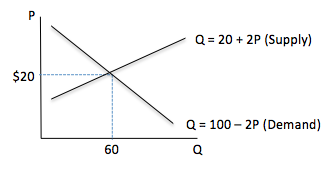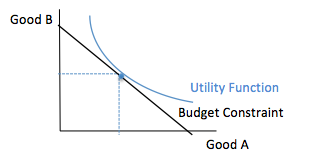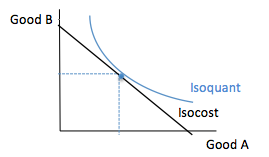Solving Simultaneous Equations
Introduction
Economic models often use a system of equations. When the same variables appear in more than one equation, they often all need to be solved at the same time --- that is simultaneously.
As long as we have the same number of equations as unknown variables --- for example two equations and two unknown variables --- we can solve these equations using a simple set of steps.
An example
The familiar supply and demand is a model, predicting what happens to prices and quantities. If the market moves toward an equilibrium, then we can predict prices and quantities by solving simultaneous equations for supply and demand. We'll solve one of these below.
Steps for solving simultaneous equations
This page will show you how to solve simultaneous equations using:
- the substitution method or
- the elimination method
Both methods give us the same answer. For each problem, choose the one that is most straightforward.
The Substitution Method
Here are the steps for solving simultaneous equations using the substitution method. The equation is for market equilibrium, a common model in both macroeconomics and microeconomics.
-
Read both equations and identify the unknown variables.
-
Pick an equation and isolate one of its variables. That is, rearrange this equation so that the variable you selected is by itself on the lefthand side of the equals sign. Be sure to follow the rules for rearranging equations and simplify as much as possible. You now have an equation for the variable you chose, defined in terms of the other variable.
-
Substitute this new equation for the variable in the other equation and simplify. When you're done with this step you will have a value for the variable you did not pick in Step #2.
-
Take the equation you derived in Step #2, plug in the value you found in Step #3, and simplify. When you're done, you will have a value for the variable you selected in Step #2.
-
Plug the values you found for both variables back into each equation and verify that the equations both hold true.
The Elimination Method
Now let's see how the elimination method works to solve for market equilibrium given linear supply and demand functions.
-
Read both equations and identify the unknown variables.
-
Choose the variable you want to eliminate first, and compare the signs and magnitudes of the coefficients on this variable in both equations.
If the coefficients are the same magnitude and the opposite sign, add the equations and then solve for the remaining variable.
If the coefficients are the same magnitude and the same sign:
Subtract the equations and then solve for the remaining variable.
If the coefficients are not the same magnitude:
Use multiplication and/or division to get the magnitudes equal and opposite in sign. Then, add the equations and solve for the remaining variable.
-
Plug the value you got from step #3 into one of your equations and solve for the other variable.
-
Plug the values you found for both variables back into each equation and verify that the equations both hold true.
Solving simultaneous equations in Macroeconomics
Solving simultaneous equations are used in many macroeconomic models.
-
The aggregate supply/aggregate demand (AS/AD) model requires two equations. Given equations for aggregate demand and aggregate supply, we can solve this system of equations to determine the equilibrium price level and the equilibrium level of output.
-
The demand and supply for money shows the impact of interest rates on the quantity of money. Given equations for money demand and money supply, economists can show the interest rate at which the money market is in equilibrium.
-
The Income-Expenditure model requires two equations. One shows the impact of total national income on national spending. The other equations indicates where the planned total spending will equal total income. Solving these two equations simultaneously shows the predicted equilibrium income.
Solving simultaneous equations in Microeconomics
In microeconomics simultaneous equations are used in models of market equilibrium, models of firm production and models of consumer behavior. Solving these equations helps economists can predict prices and quantities.
-
In the model of consumer choice (here, applied to utility maximization), equations describe consumer preferences for a set of goods and services subject to budget restraint. Solving these simultaneous equations predicts consumer behavior.
-
Models of cost minimization for business firms use simultaneous equations to describe production possibilities and cost constraints. Solving these simultaneous equations indicates a firm's cost minimization for different output levels.


![[creative commons]](/images/creativecommons_16.png)




